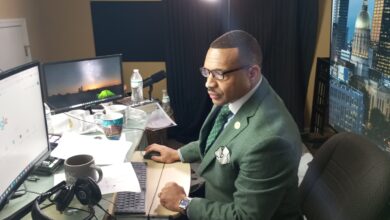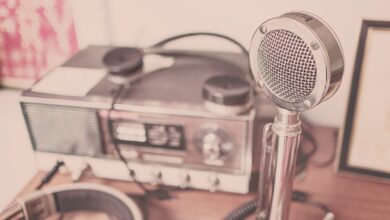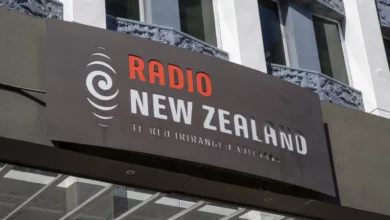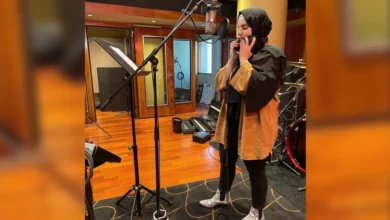
ALEXANDRIA — The high windows of Hotel Crillon on Alexandria’s Mediterranean coastline give out onto a stunning horizon. But open them, and with a gust of fresh sea air honking trucks and car horns aggressively burst into the room too. Noise pollution is part of city life, but how much of our sonic surroundings do we actually take in, and how much do we subconsciously block out?
Julia Tieke and Biret Schuck’s Mini Radio Academy is part of the Alexandria Streets Project, an audio art project for and about public places in Alexandria. The three-day academy comprised nine workshops led by experts in the field and was open to anyone interested. Collaborating with Alexandria’s first online radio station, Radio Tram, the participants came from backgrounds as diverse as literature and architecture.
They were introduced to Alexandria’s sonic landscape through a “soundwalk.” With eyes closed, they were encouraged to tune into audible things around them — the quietest sound, the hum of buildings, different footsteps.
Yara Ahmed, an English Literature graduate attending the course for an insight into journalism, said she felt depressed at the sounds around her, “All I could hear were machines. Even when I tried to listen to nature, when I heard the wind it was blowing rubbish along the street.”
In contrast, architect Khlood Abdu Allah said she could hear the shape of the buildings around her thanks to the wind. A blogger who writes fictional conversations between herself and Cleopatra, the training will allow her to document her own idea of history, “When I walk around the city, I always think I’m walking the same steps that Alexander the Great walked.”
The experiment proved interesting for Tieke, who commented that sonic landscapes are shaped by our familiarity with what’s around us — she wouldn’t have recognized the drip of an air conditioning unit, for example, whilst in contrast, discussions are taking place in Europe now about how the sound of electric cars should be designed.
Tieke admits that there is a political motivation to the course, “You should care about your acoustic environment and be more aware of what is going on around you. You can’t close your ears, but it’s good to be able to switch to conscious listening.”
As for radio’s place within a predominantly visual society, sound art links us back to an era when the social landscape was shaped less by vision. “In Alexandria,” said Schuck, “people used to gather to listen to outside broadcasts of Om Kalthoum.” Still today the furthest reaches of the community are delineated by the sound of the call to prayer. Although changing with the introduction of the pre-recorded adhan, Egypt’s is still very much an aural environment.
Antoun Samuel, a lawyer, wanted to document the rich and varied history of Fouad Street in Alexandria. “I came on the course to try and work out exactly what it is I like so much about radio,” he said.
“Radio has a special impact,” said Tieke. It’s truly a “social’ medium, because sound surrounds us. It’s different to visual media because that is between one person and what they see in front of them. [Radio fits in to] our oral culture of storytelling.” Furthermore, Tieke feels that radio has a special place in a democratic media landscape; “It’s easier to work in radio than in TV — the barriers are lower.”
For this reason it has been very important for the project to support Radio Tram by inviting media professionals to advise on funding strategies. “We wanted to be in Alexandria because there is so much going on in Cairo already,” she said. “There is already a second online radio station here which started last September, called Radio Fresca.”
Workshop director and head of media training consultancy Egypt Media Development Programme, Tarek Atia, believes that locating the academy in Alexandria is important, because of Egypt’s “inherited Cairocentric” media landscape. “The general trend in media is the move towards localization — soon each person will become their own TV or radio station. So if you want to compete you have to address your immediate community,” he said. “And until the legal framework allows for independent FM and AM stations to appear, then people will express themselves locally. But in Alexandria it’s interesting, because it is a city of 6 million people which doesn’t even have a daily newspaper.”
Atia said of the academy’s remit that “radio is like a friend or companion. There is a very special relationship between listener and speaker — you listen at home, in the car or on headphones. It makes radio extremely powerful. [It’s good that in the course there are] people who don’t have a media background. They bring a fresh perspective, and the workshops can help to bring the importance of their work out. They begin to shine.”
As for the participants themselves, the training does in fact bring out their best. Participant Yara Ahmed said at the end of the first full day she feels her confidence has taken a huge leap forward, “Before I was scared of going up to people and talking to them, but when you have an actual reason to, it’s much easier. I have learnt to do something I never thought I would be able to.”




